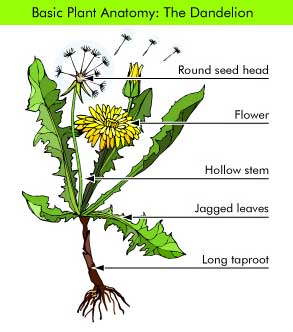Dandelion
Contents
Description & Habitat
There are literally hundreds of species of Dandelion. It is a hardy perennial that can grow up to 12 inches high. The leaves are deeply notched, spatula-like, shiny and hairless. They're capped with bright yellow flowers which are sun-sensitive. The flowers will open in the sunlight and close in the evening, or on a gloomy day. The roots are fleshy and brittle, filled with a white milky substance that's bitter and has a slight odor.The Dandelion is widely distributed throughout most of the world, and seen by many as a troublesome weed. However, it's a valuable herb with many culinary and medicinal uses.
Nutrients
Dandelions are a rich source of vitamin A, B complex, vitamin C & D. They also contain minerals such as iron, potassium and zinc.
Collection
All parts of the dandelion can be used either for eating, drinking or as a medicinal potion. The roots are best collected between June and August, when they are most bitter. They should be split lengthwise before drying. Leaves can be collected at any time. It's best to let the Dandelion rest after harvesting, so that any insects will have an opportunity to evacuate.
Food & Drink
Dandelion leaves are commonly used in salads, sandwiches and teas. The roots are used in coffee substitutes, and the flowers may be made into wine.
Medicinal Uses
Dandelion roots and leaves are often used for medicinal purposes. Dandelion is a very powerful diuretic (increases the secretion and flow of urine), and it can safely be used in cases of water retention due to heart problems.
It also stimulates kidney function, and is a hepatic (supports and stimulates the liver, gall bladder, spleen and increases flow of bile), cholagogue (stimulates bile flow from gall bladder and bile ducts into the duodenum), anti-rheumatic, laxative, tonic and bitter (stimulates secretions of digestive, encourages appetite).
As a hepatic and cholagogue, Dandelion root may be used for inflammation/congestion of the liver and gall-bladder. It is specific in cases of congestive jaundice, and can also be very effective for muscular rheumatism.
The Dandelion herb is a valuable general tonic for the liver, and helpful for kidney disease, swelling, skin problems, heartburn, chronic gastritis and stomach ache. Modern day uses are appetite stimulant and digestive aid.
Dandelion may be combined with Barberry or Balmony for liver & gall-bladder, or Yarrow and Couchgrass for water-retention.
Preparation & Dose
Mix 2-3 teaspoons of the root in 1 cup of water and bring to a boil, let slowly simmer for 10-15 minutes, drink three times per day. Tincture of 5-10ml. can also be used 3x's daily.
Available Forms
Dandelion herb can be purchased for use either fresh or dried, tincture, teas, tablets or capsules. It is often combined with other herbs for various ailments.
Drug Interactions
Dandelion, being a diuretic, may increase the excretion of drugs from the body. Caution must be used for those on prescription medication, and consultation with the physician is always recommended.
Those who are using the drug Lithium for depression must first have doctor's approval, as it may worsen the side-effects.
The species of Dandelion known as Taraxacum Mongolieum (Chinese Dandelion), may decrease the digestive tract's absorption of antibiotics such as Cipro, Ofloxacin and Levofloxacin.
Taraxacum Officinale (common Dandelion) may also interfere when using antacids such as Zantac, Pepcid, Tagamet, etc.

